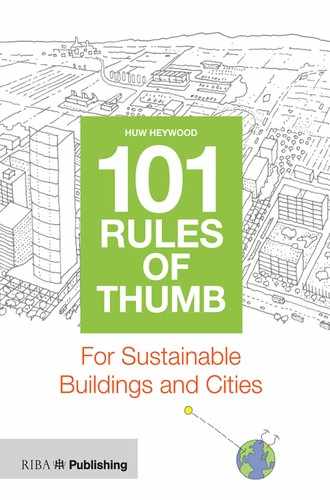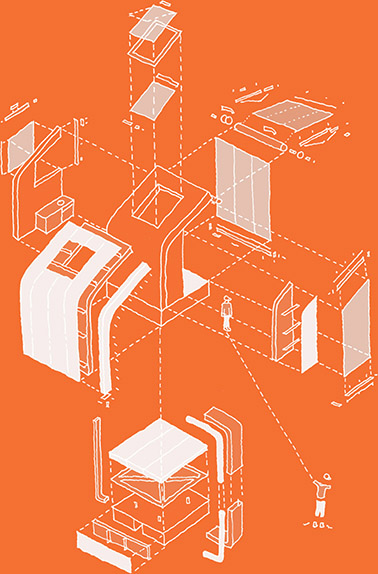22. The Earth is the Source of all Building Materials
It is worth reminding ourselves of the basic fact that the earth is the source of all the raw materials from which we make everything used to construct our buildings (and, indeed, everything else we use in our lives). Many of these resources are finite: they will run out. Others may be replenished, but we must manage all the earth’s resources with future generations in mind.
 Links with rules 1, 2, 23, 45
Links with rules 1, 2, 23, 45
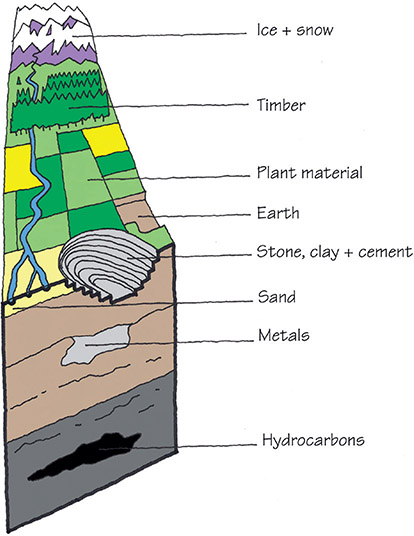
Rule 22
23. Do More with Less–Practise Economy of Resources
Buildings consume half of the world’s resources and most of these are non-renewable, such as metals and minerals. Our consumption of global resources is set to rise fourfold by 2050, as the population of the world continues to grow. In designing our buildings and cities we must practise economy of global resources, conserving them in both construction and operation. Consider the size of building needed, the efficient use of materials and the reuse of waste. Ensure all components and systems are working hard, preferably with each doing more than one job.
 Links with rules 1, 5, 6, 22, 33–37, 42, 45, 91
Links with rules 1, 5, 6, 22, 33–37, 42, 45, 91
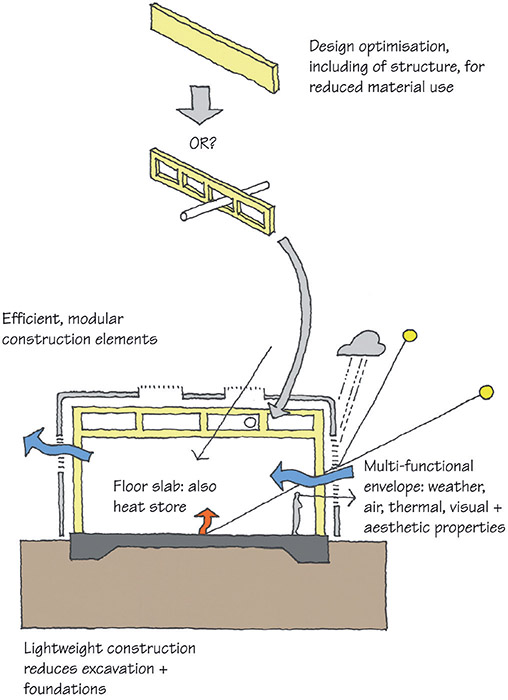
Rule 23
24. The Amount of Energy Needed to Run a Building is Ten Times the Energy Used to Make it
The operational energy over the lifetime of a typical home will be ten times the energy used to make it–the embodied energy. Make sure buildings are highly energy efficient, then focus on embodied energy.
 Links with rules 1, 11, 16, 25, 26, 35, 45, 87
Links with rules 1, 11, 16, 25, 26, 35, 45, 87
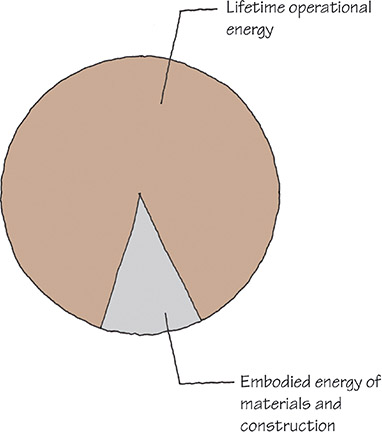
Rule 24
25. Use Embodied Energy to Reduce Operational Energy
Every building material has embodied energy: the energy expended in its extraction, production, transportation, installation and dismantling. We must aim to reduce embodied energy by designing long-life, durable, adaptable and low-energy-use buildings. Use energy-intensive materials like concrete, brick, glass and insulation only sparingly–and when used, they should be employed to help reduce operational energy.
 Links with rules 1, 11, 15, 24, 35, 45, 62
Links with rules 1, 11, 15, 24, 35, 45, 62
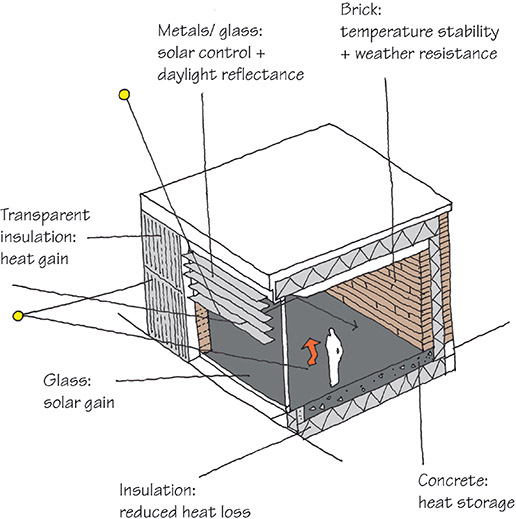
Rule 25
26. Follow the Rules of Thumb for Low-Energy Architecture
Sustainable architecture must be low-energy-use architecture. There are simple rules of thumb for the designer, which show how to use sun, wind, daylight and building form to reduce energy use.
 Links with rules 1, 5, 6, 13, 14, 24, 32, 45, 84, 85
Links with rules 1, 5, 6, 13, 14, 24, 32, 45, 84, 85
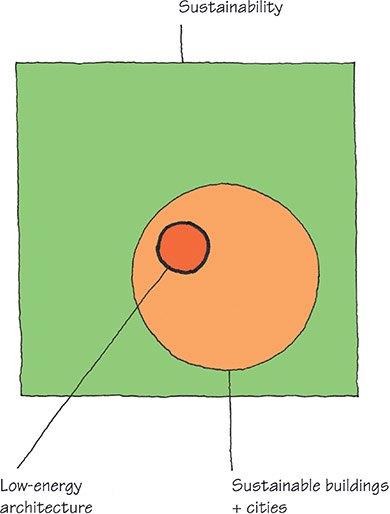
Rule 26
27. Low-Energy Design First, Renewables Next: Think ‘Fabric First’
Energy means either electricity or heat. Even for buildings that will rely on renewable or low-carbon energy sources, first design to minimise energy use by maximising on natural and free sources of heating, cooling and lighting and by designing an appropriate envelope. Only then consider renewable energy sources. The maxim to remember is ‘Fabric first’.
 Links with rules 1, 28–30, 31, 32, 45
Links with rules 1, 28–30, 31, 32, 45
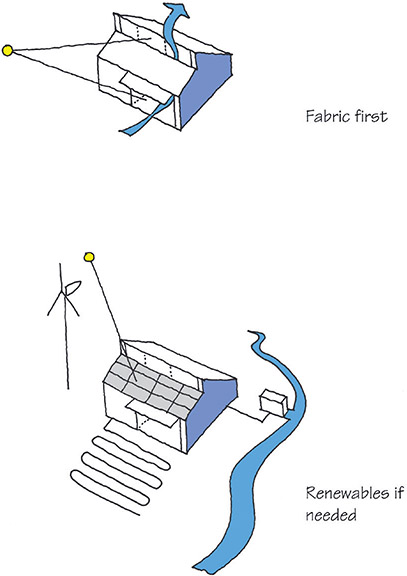
Rule 27
28. Renewable Energy Sources: Water
By using the energy of a river to drive a turbine, microhydropower can provide electricity for a house or a small group of buildings. Ideal locations for this application include the world’s mountain ranges, which tend to experience year-round rainfall, and other regions whose rivers have a large vertical drop (or ‘head’) or an adequate flow rate. High rates of water flow tend to be seasonal, so combine hydro with solar generation. Up to 9.8kW can be produced for each m3/s of water that falls 1m. A head of at least 10m is ideal, with 1.5m as an absolute minimum.
 Links with rules 1, 21, 27, 45
Links with rules 1, 21, 27, 45
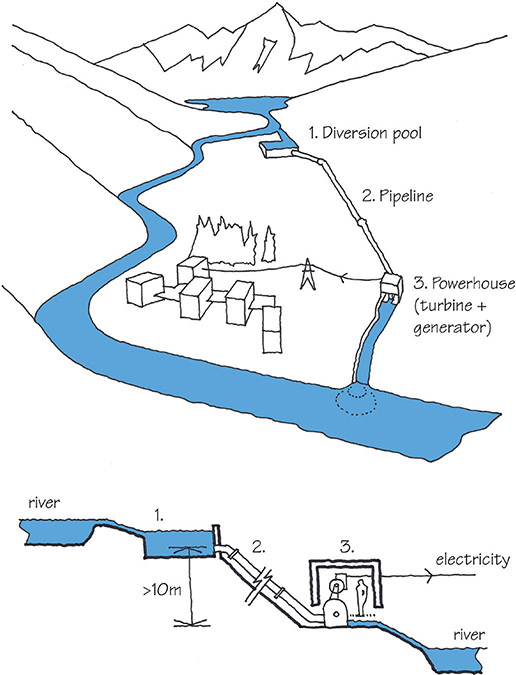
Rule 28
29. Renewable Energy Sources: Wind
If the average wind speed is more than 5m/s, then consider a wind turbine for electricity generation. In urban areas this will be a challenge, unless your building is 15 storeys or taller. Remember, take a year’s wind-speed measurements first, and obtain statutory approvals. A small, 1.5kW turbine can provide one quarter of a typical home’s use in the UK, one tenth in the USA and about the average consumed in India today.
 Links with rules 1, 21, 27, 45, 53, 64
Links with rules 1, 21, 27, 45, 53, 64
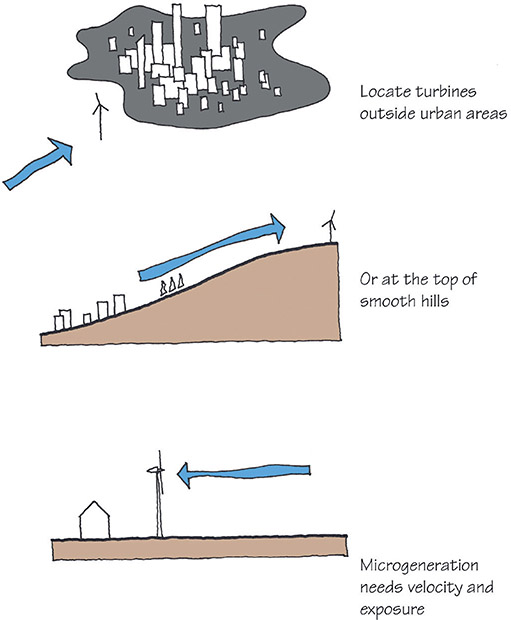
Rule 29
30. Renewable Energy Sources: The Sun
Unlike water and wind, the sun can provide both electricity and heat. Consider electricity-generating photovoltaic (PV) panels and solar-thermal collectors for hot water. Electricity needs to be stored if not used immediately, or else fed into a power grid. Community-wide arrays for heating and electricity will be more efficient than single installations. Biofuels, which can produce both heat and electricity, may be less damaging than fossil fuels in regions where previously used land can legitimately be diverted from food-crop growth, always providing that ecosystems are protected.
 Links with rules 1, 21, 27, 45, 53, 60
Links with rules 1, 21, 27, 45, 53, 60
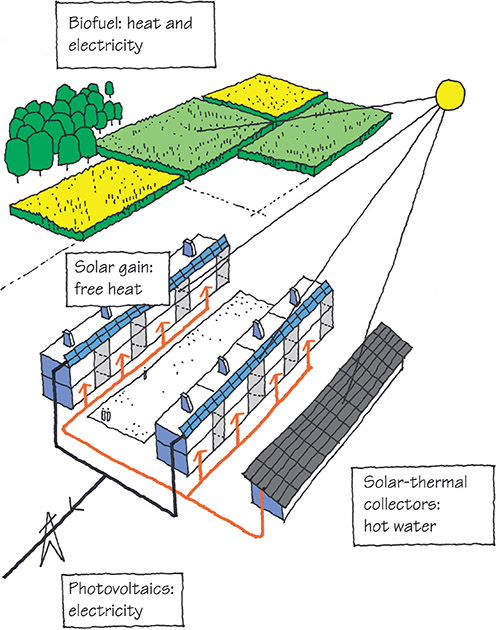
Rule 30
31. Use Alternative Energy Sources to Heat and Light Cities
Districts–and, indeed, entire cities–may be powered by renewable energy sources. Combined Heat and Power (CHP) plants, wave and wind power are all possibilities. Sustainable cities convert their waste into energy, heating and powering the city from a single, large-scale facility. Other forms of biomass, such as landfill gas and wood waste, as well as residue from industrial processes, can be used to power CHP facilities. CHP plant is ideally located on brownfield sites near to the point of continuous energy usage (such as those for hospitals, public buildings or manufacturing), and unlike wind and solar it can operate continuously.
 Links with rules 1, 27, 32, 45, 99
Links with rules 1, 27, 32, 45, 99
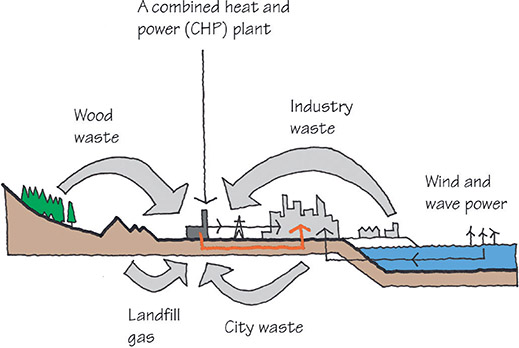
Rule 31
32. Use Efficient, Low-Carbon Energy Sources
There are renewable energy sources (wind, sun and biofuel) and there are low-carbon sources (heat pumps, natural-gas CHP or electricity from a Combined Cycle Gas Turbine [CCGT] plant, which reuses normally wasted heat to generate more power than a traditional plant). Sometimes renewable sources are unavailable or, perhaps in cities, inefficient. Low-carbon sources are the next choice. For the space heating of multiple dwellings or for district-scale developments, a heat pump–powered by electricity from a low-carbon grid source and drawing heat from the earth, air or water–will be more efficient and less polluting than a gasfired boiler. Remember that for cooling, a heat pump can be reversed.
 Links with rules 1, 26, 27, 31, 45, 91
Links with rules 1, 26, 27, 31, 45, 91
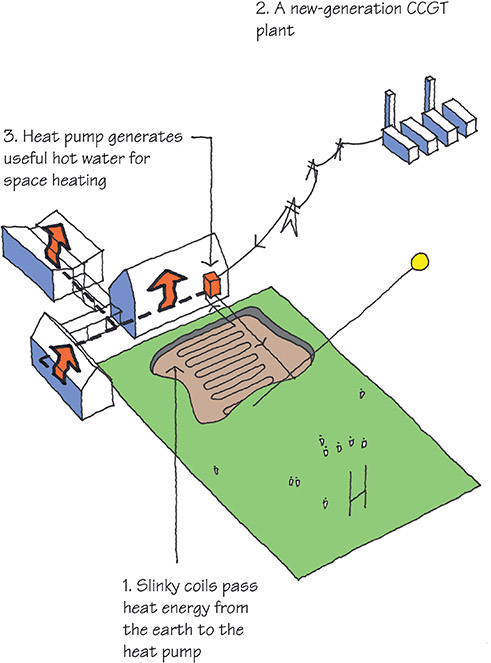
Rule 32
33. Sustainable Materials 1: Use Reclaimed, Reused, Recycled Materials
Our first choice should be materials that are already available. For the innovative designer, waste (reclaimed) materials are still a largely untapped resource. Reused materials are those put to the same use in a new situation; they might include steel or brick. Recycled materials are reprocessed, often requiring the input of energy and additional resources, although they are generally preferable to virgin or scarce non-renewable materials. Non-renewable materials (those that can be ‘harvested’ only once) should be used sparingly. The ultimate challenge is to use only renewable and reused materials, and no non-renewables.
 Links with rules 1, 5, 6, 23, 44, 45
Links with rules 1, 5, 6, 23, 44, 45

Rule 33
34. Sustainable Materials 2: Use Renewable and Plentiful Materials
If virgin materials are needed, use renewable resources such as wood and fibre: renewable, organic materials are environmentally preferable in construction, as long as our rate of usage does not exceed their rate of growth. There are also many materials that exist in the earth in very large quantities, and which will not be exhausted, including stone, earth, clay, sand and gravel.
 Links with rules 1, 5, 6, 23, 45
Links with rules 1, 5, 6, 23, 45
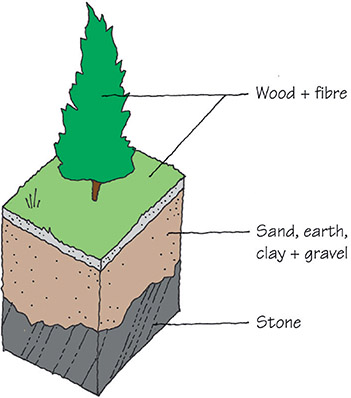
Rule 34
35. Sustainable Materials 3: Use the Lowest-Carbon Version of a Material
Building materials are responsible for cumulative CO2 emissions: fossil fuel-derived energy is used at each stage of their life (extraction, production, transportation and incorporation.) So choose organic, not highly processed materials, ensure a high recycled content, and find alternative low carbon constituents. Seek manufacturers who use low carbon energy, and suppliers and contractors who can prove they care about a low carbon world. Consider:
- Zero-cement-content concrete
- Reused timber and steel
- High-reclaimed-content steel, carpet, plasterboard
- Organic alternatives for insulation
 Links with rules 1, 5, 6, 23, 24, 25, 45
Links with rules 1, 5, 6, 23, 24, 25, 45
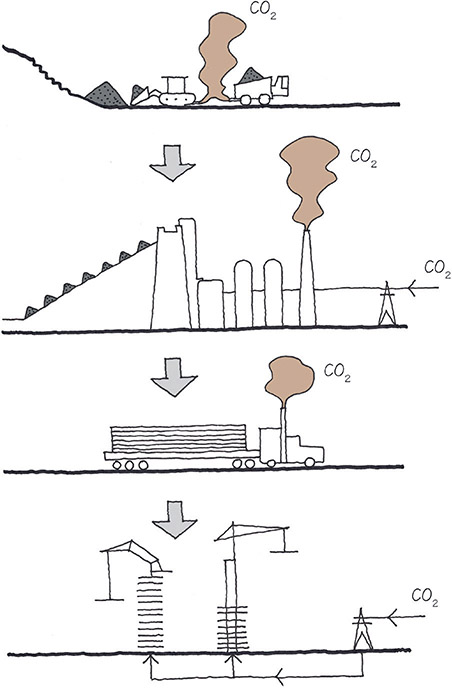
Rule 35
36. Sustainable Materials 4: Source Materials Locally
In Europe alone, transportation of building materials accounts for nearly 10% of greenhouse-gas emissions. Minimise the energy needed for transportation by sourcing heavy materials which are not made on site, such as stone and brick, from close to where they are needed. Pollution and other environmental nuisances will also be reduced. Lightweight and virgin materials should be sourced within 100km. Reclaimed materials may justifiably be brought to the building site from a more distant source. Always check the environmental credentials of every material, whether sourced locally or globally, before making choices.
 Links with rules 1, 5, 6, 23, 45, 98
Links with rules 1, 5, 6, 23, 45, 98
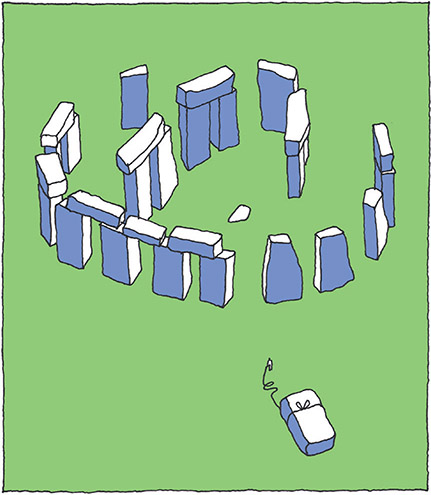
Rule 36
37. Sustainable Materials 5: Use Suitable and Durable Materials
Durability comes from a combination of durable materials, durable design and durable construction. Choose materials based on properties appropriate to place and circumstances, with the health of building occupants in mind (they should be benign in terms of chemical composition and emissions) and where the lifetime ecological profile can be identified as being low-impact. Use published checklists as a guide, and ask searching questions of manufacturers and suppliers.
 Links with rules 1, 2, 5, 6, 23, 45, 53, 69, 72, 73, 90
Links with rules 1, 2, 5, 6, 23, 45, 53, 69, 72, 73, 90
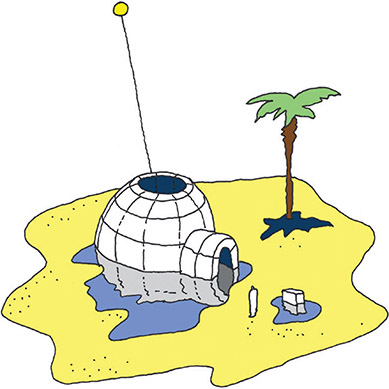
Rule 37
38. Water, Like Oil, is a Finite Resource–Conserve it
Earth is a water world; 70% of the planet’s surface is water. All we will ever have exists within earth’s hydrologic system today, but 97.5% is salt-water and most of the rest is frozen under the earth. Only 0.008% of global water is readily available for human use. In the UK alone, we each use on average 163 litres daily, and there is increasing global pressure on clean supplies. So, firstly reduce water use with efficient taps, showers, toilets and outdoor systems. Then encourage good water-management behaviour with clear instructions. Finally, maintain water systems to eliminate waste.
 Links with rules 1, 5, 6, 11, 39, 40, 45, 69, 84
Links with rules 1, 5, 6, 11, 39, 40, 45, 69, 84

Rule 38
39. Use the Right Quality of Water in the Right Place
After reducing demand (Rule 38), the next step is to reuse recycled greywater (water from basins, baths and showers) for use in toilets, washing machines and gardens instead of the high-quality drinking water we commonly use. Where possible, recover heat from waste water too. Also, in many regions rainwater harvesting can supply irrigation and clothes-washing water, and in some locations on the planet it is of drinking quality.
 Links with rules 1, 38, 40, 45
Links with rules 1, 38, 40, 45
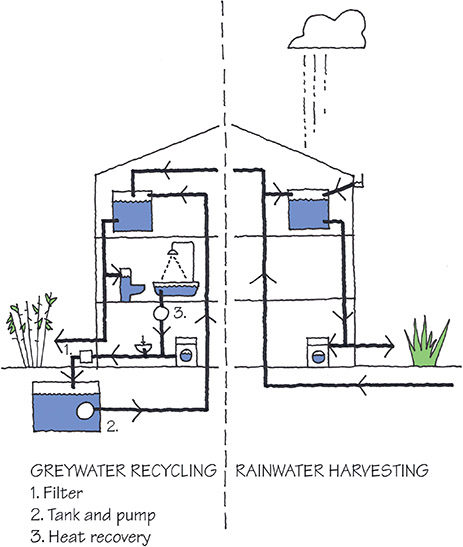
Rule 39
40. Gather Water in Rain Gardens, Water Squares and Swales–Use Suds
In our cities, we often channel rainwater from hard landscape surfaces into the sewerage system. The result is increased risk of regional drought as groundwater, which is held naturally underground within permeable rock formations known as aquifers, is not replenished. Piping rainwater directly to watercourses also increases flood risk and pollution problems. A Sustainable Urban Drainage System (SUDS) aims to mimic natural water drainage, allowing rainwater to permeate into the ground while safely storing excess. Use permeable surfaces to permit infiltration of rainwater and design inventive, water-retaining landscaping from which rainfall can also be harvested.
 Links with rules 1, 20, 38, 39, 45, 58, 66, 80, 99
Links with rules 1, 20, 38, 39, 45, 58, 66, 80, 99
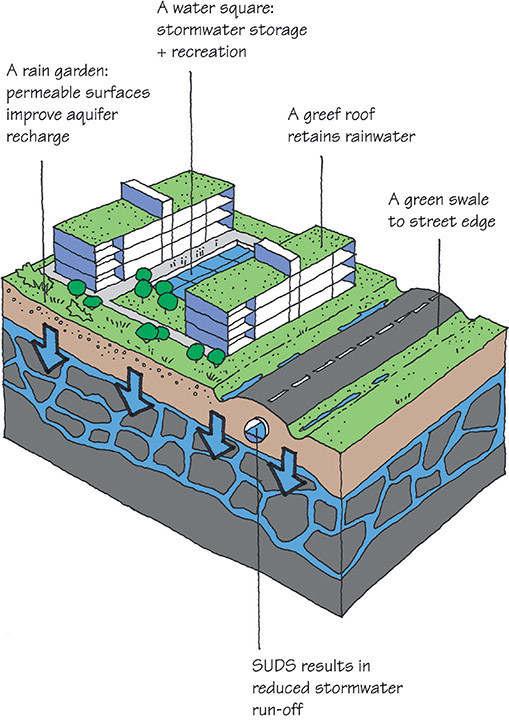
Rule 40
41. Use Brownfield, not Greenfield
A greenfield site is unbuilt land; an urban brownfield site has been previously used. Brownfield sites might be polluted but biodiverse, so care is needed in decision-making. Use of greenfield sites will almost always increase transportation and CO2 emissions, contribute to urban sprawl, impact on biodiversity and lead to the depopulation of city centres. Intelligently developed brownfield sites can form the basis of new urban communities within already established cities. If not built on, and once clean and unpolluted, a brownfield site may be used for urban agriculture.
 Links with rules 1, 45, 46, 76, 80, 82, 97
Links with rules 1, 45, 46, 76, 80, 82, 97
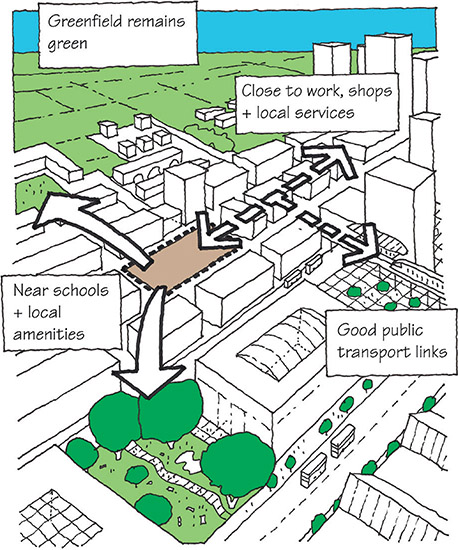
Rule 41
42. Banish Construction Waste
One third of all UK waste sent to landfill comes from construction and demolition sites, and this includes excavation material, materials delivered but never used and general waste from building processes. Waste contributes to air, land and water pollution; it must be banished through good design, specification and construction practices.
 Links with rules 1, 5, 6, 23, 43, 44, 45, 47, 86, 92, 99
Links with rules 1, 5, 6, 23, 43, 44, 45, 47, 86, 92, 99
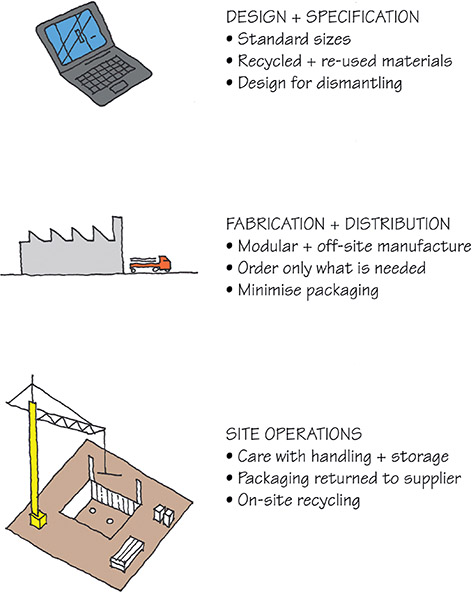
Rule 42
43. Think ‘Back to Front’
Design with the distant future in mind by asking yourself at the beginning:
- What will happen, at the end of a building’s life, to all the materials and components you specify?
- How could they become part of a new process of sustainable design?
Design from the outset for future deconstruction, and reuse of every part.
 Links with rules 1, 42, 45, 93
Links with rules 1, 42, 45, 93
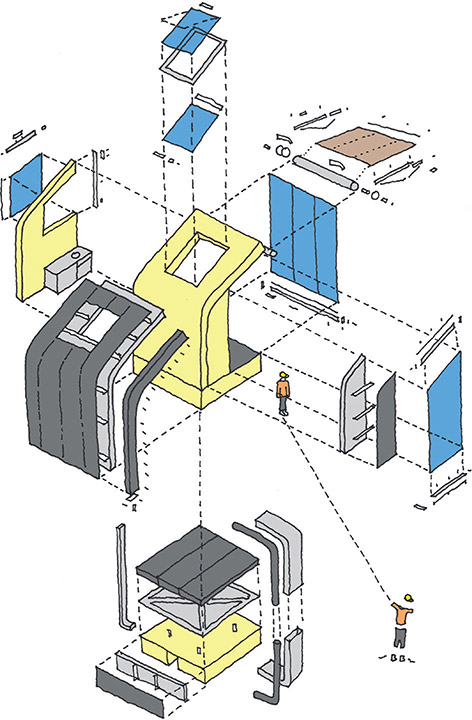
Rule 43
44. Recycling is the Last Resort–Remember the Four ‘R’s
Reduce, reuse, recover and recycle–in that order. This is the mantra for minimising environmental impacts from materials, water and energy usage in sustainable design and construction. Recycling is just one of the four ‘R’s. Too often, recycling of materials and resources is the result merely of overconsumption or lack of consideration of resource life cycle. It takes further energy inputs to break down waste products, so recycling should be considered in light of the other ‘R’s.
 Links with rules 1, 33, 42, 45
Links with rules 1, 33, 42, 45

Rule 44
